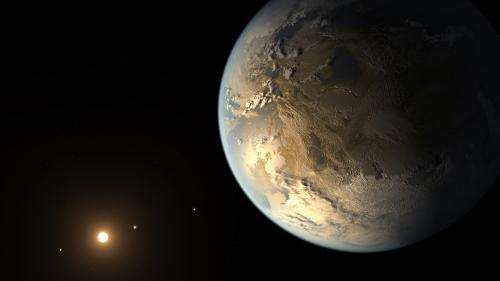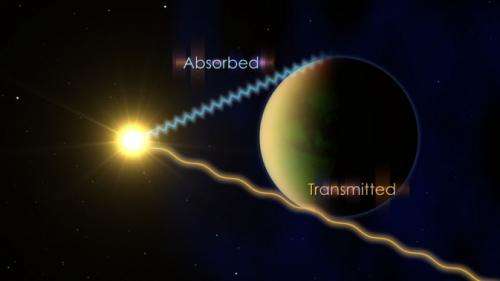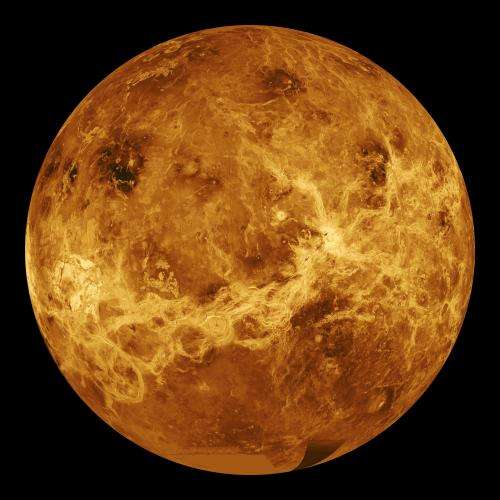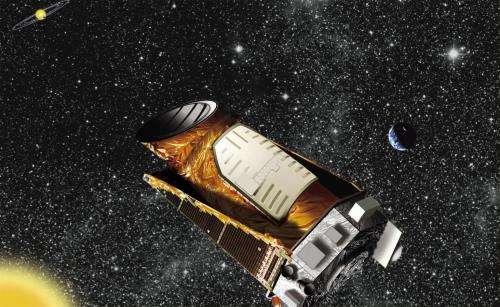Oxygen in exoplanet atmospheres could fool search for life

Oxygen is a signal of life on our own planet, but that's not necessarily the case elsewhere. Particularly when it comes to young planets, signs of oxygen do not necessarily indicate the presence of biological processes, new research argues.
Water vapor in the upper atmosphere of a young planet could break into hydrogen and oxygen by incoming ultraviolet and extreme ultraviolet rays from the parent star.
"Atomic hydrogen is so light that it can escape to space and lead to the oxidization of the planet," said Robin Wordsworth, a geophysicist at the University of Chicago. "It will just keep continuing and oxidizing the atmosphere. That's what we try and investigate in the paper."
The researchers investigated water photolysis, which happens when a water molecule is torn apart by high-energy photons from the sun. Usually the water (two hydrogen atoms and an oxygen atom) is broken into two parts, OH and H. The H escapes to space because it is so light. Over time, more oxygen molecules build up until eventually O2 (molecular oxygen) form as well.
"The real novelty of our paper was to study the consequences of hydrogen loss from water photolysis, when molecules break down into smaller units after absorbing light," said Wordsworth.
Wordsworth co-led the research with Raymond Pierrehumbert, who is a geophysicist in his department.
The paper, called "Abiotic oxygen-dominated atmospheres on terrestrial habitable zone planets" is available on the pre-publishing site Arxiv and has been accepted for publication in Astrophysical Journal Letters.
Due to their diminutive size, Earth-sized planets are hard to spot in telescopes searching for exoplanets. They don't tug on their parent stars as much as the Jupiter-sized worlds, which induce "wobbles" in a star's movement. If the terrestrial-sized planets pass across the face of their star, their shadow is also incredibly tiny. Trying to pick out details such as land features or even atmospheres is also difficult because of their small size. For now, astronomers expect better success with bigger worlds, of which there are plenty to choose from.
Most planets found outside the Solar System have been Jupiter's size or larger. However, NASA's Kepler Space Telescope has begun spotting more small worlds. A large "planet bonanza" of 715 new worlds was released in February. Most of these newly found exoplanets are "super-Earth" sized, of about two to 10 times the size of our own planet. Kepler also spotted several planets that are about Earth's size, including one that is slightly larger than Earth in a discovery announced April 18.
Kepler pioneered a new technique that will likely accelerate the pace of Earth-sized planet discoveries in the next few years. The theory is called "verification by multiplicity" and it only works for stars that have more than one planet.
If a star is part of a multiple-star system, those other stars can appear to behave like planets. Stars can produce wobbles in each other, or cast shadows as they cross each other's faces. The immense gravity of these stars, however, would throw the system into chaos after a time. Planetary systems in single-star systems would be far more stable because the planetary gravities are not nearly as strong.
So odds are, if scientists spot multiple shadows crossing a star or detect several things "tugging" away at it, the source for these disturbances are planets and not stars. The February release of data only encompassed two years, or half of Kepler's data, so there will likely be hundreds more discoveries after the second half is analyzed, scientists said at the time.

With an abundance of smaller planets in hand—coupled with better telescope technology—astronomers hope to one day probe the atmospheres of super-Earths to see what sort of elements they contain. This could take decades to achieve, however, so astronomers are also using other tools to predict habitability.
What is habitable?
Finding Earth-sized planets is only part of the equation. The planets need to be in the "habitable" region of their star—the area where liquid water could exist. The zone is different for various types of stars. For example, a cooler star than our Sun would have a habitable zone that is closer to that star than our Solar System.
Habitability also depends on the star's variation in activity. For example, an erratic star would have inconsistent radiation, which could make the planet's temperature swing too hot or too cold for a time. Other factors could include the presence of moons, or what is contained in the planet's atmosphere.
Some of Wordsworth's research is focused on predicting what sorts of planets would have life-friendly atmospheres, but this one is about detection of bio-signatures, not detection of habitable conditions. Earth-sized planets produce such faint spectral signatures that nobody has analyzed a terrestrial exoplanet's atmosphere yet. When the time comes, the scientists want to be prepared.
"If we have an exoplanet with oxygen in its atmosphere, just saying it's unlikely it's an abiotic atmosphere is not enough," he said. "We need to take a step beyond that with better observational constraints for these kinds of atmospheres."
The escape of hydrogen, he said, is not strongly affected by nitrogen or argon; it's more about how water propagates into the upper atmosphere. Nitrogen makes water get trapped in the planet's lower atmosphere at Earth-like temperatures, he said.
"It's hard for me to think of a precise analogy, but an imprecise one is the pressure cooker. Nitrogen is like the walls of the pressure cooker, keeping the water contained," Wordsworth said. "If the water is cold-trapped, it can't reach the upper atmosphere where most ultraviolet rays from the Sun get absorbed and hence can't be broken up. Without the nitrogen, water vapor is free to mix all the way up."
"On present-day Earth water condenses out in the troposphere keeping the stratosphere dry and hence protecting against H2O photolysis and the subsequent loss of hydrogen to space," Wordsworth said. "Without nitrogen, this wouldn't happen. I think that one thing about the exercise is we have to be much broader about how different planets can evolve."
Luckily, the answer to that may partly lie in our own Solar System.

Checking out the neighbors
With exoplanets so far away, Wordsworth adds that it is important to do studies of planets in our own Solar System to better understand the limits of habitability. Venus and Mars provide excellent comparisons to Earth, Wordsworth added, and it's possible to send a probe to either planet to learn more about them. A distant exoplanet, by contrast, would be next to impossible to get to with current technology.
"I'm a huge believer in comparative planetology," he said. "We can use Solar System research as an exercise to understand more about exoplanets."
On Venus, the ratio of hydrogen to "heavy hydrogen" (deuterium, an isotope of hydrogen with a nucleus containing one proton and one neutron) hints that the planet lost water in the past. The ratio of these molecules shows an overabundance of deuterium to hydrogen in the atmosphere, so scientists believe that early in the planet's history, the lighter hydrogen molecules escaped to space while the heavier deuterium molecules mostly stayed put. (This is assuming Venus had a D/H ratio similar to what we see on Earth today).

More study is needed to understand this. Some scientists theorize Venus' weak magnetic field made it more vulnerable to solar radiation, which knocked the hydrogen out of the atmosphere. Mars, he added, has a thin atmosphere and a cold surface. Temperature is critical in determining how much water is evaporating into the atmosphere.
Wordsworth said he is looking forward to the arrival of NASA's Mars Atmosphere and Volatile EvolutioN (MAVEN) mission, which is expected to reach the Red Planet in September. The mission will be able to track atmospheric escape of molecules right now, and perhaps make informed extrapolations of what happened in the planet's past.
"My feeling is that certainly Mars had a thicker CO2 atmosphere early on, and water would have been very stable on the planet's surface. It deserves further study," Wordsworth said.
Researchers also shouldn't forget Earth, he said. Calculations of our own atmospheric escape shows that nitrogen should have been lost to space long ago, so why there is so much on our planet is a mystery.
More information: "Abiotic oxygen-dominated atmospheres on terrestrial habitable zone planets." Robin Wordsworth, Raymond Pierrehumbert. arXiv:1403.2713 [astro-ph.EP] 11 Mar 2014. arxiv.org/abs/1403.2713
Journal information: arXiv , Astrophysical Journal Letters
Provided by Astrobio.net




















